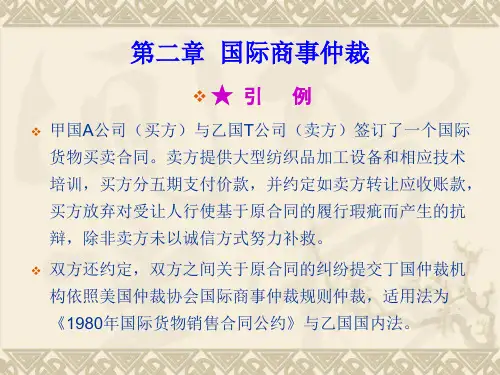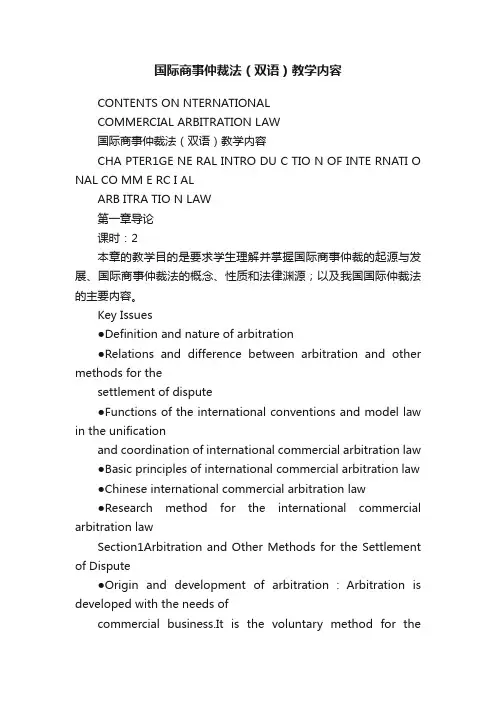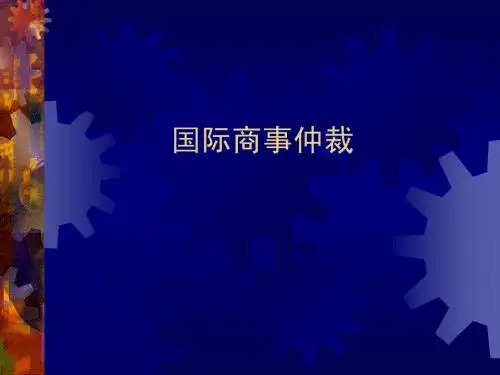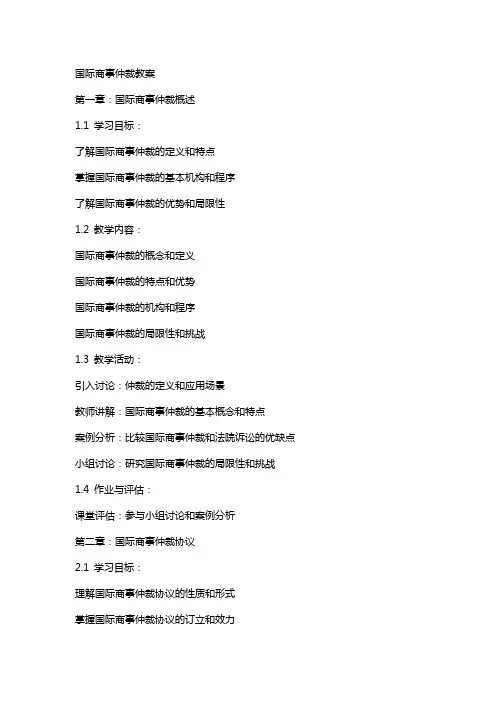第6章-国际商事仲裁课件知识讲解
- 格式:ppt
- 大小:166.00 KB
- 文档页数:41





国际商事仲裁法(双语)教学内容CONTENTS ON NTERNATIONALCOMMERCIAL ARBITRATION LAW国际商事仲裁法(双语)教学内容CHA PTER1GE NE RAL INTRO DU C TIO N OF INTE RNATI O NAL CO MM E RC I ALARB ITRA TIO N LAW第一章导论课时:2本章的教学目的是要求学生理解并掌握国际商事仲裁的起源与发展、国际商事仲裁法的概念、性质和法律渊源;以及我国国际仲裁法的主要内容。
Key Issues●Definition and nature of arbitration●Relations and difference between arbitration and other methods for thesettlement of dispute●Functions of the international conventions and model law in the unificationand coordination of international commercial arbitration law●Basic principles of international commercial arbitration law●Chinese international commercial arbitration law●Research method for the international commercial arbitration lawSection1Arbitration and Other Methods for the Settlement of Dispute●Origin and development of arbitration:Arbitration is developed with the needs ofcommercial business.It is the voluntary method for thesettlement of dispute based onthe parties agreement.●Nature and characteristics of arbitration:Arbitration is contractual in nature basically asa method for the settlement of dispute.No arbitration agreement,no arbitration.Thismethod later incorporated into the legal system of the State.The national court shallenforce the arbitration agreement as well as the arbitral awards in accordance with the local law.In this regards,it also carries out the judicial nature.●Relationship between arbitration and other methods for the settlement of dispute●Arbitration law governing arbitration:Arbitration incorporated advantages from bothADR and litigation.It is more flexible as ADR as to the parties autonomy.The arbitral award could be enforceable as the court judgment.Section2International Commercial Arbitration Law■Origin and development of international commercial arbitration law:It origins from thenational law and international conventions.■Parties for the international commercial arbitration law:mostly between the parties with equal legal status,that is the private parties.■Subject matters of the international commercial arbitration law--relationship between the parties under the arbitration agreement--relationship between the arbitration institution,arbitrationtribunal and the parties--national courts’supervision on the international commercial arbitration law ■Sources of international commercial arbitration law--Domestic arbitration law--International legislation:bilateral judicial cooperation treaty,international convention, model lawSection3Basic Principles of International Commercial Arbitration Law■Parties’autonomy:the parties may select the arbitration institution,applied rules,arbitrators, languages,place of arbitration and so on.■Independent and impartial settlement disputes by the arbitral tribunal:arbitrators are different from national judges as to the field of implementation of law.The functions for the settlement of dispute are similar.The only objective for the arbitrator is to render awards independently and impartially.■National courts’supervision on the arbitration:Since the national courts implement law in public field,the arbitral awards are subject to the courts’supervision.The court may set aside national award or may refuse national and foreign awards at the request of the party according to national law.Section4International Commercial Arbitration Law in China ■Domestic arbitration law■Bilateral judicial cooperation treaty and international convention to which China is a partySection5Construction of the Course■Arbitration institutions■International arbitration agreement■Arbitration tribunal■Arbitration procedures■The law governing the arbitration■Award and remedies■Court supervision本章教学要点:1、仲裁是当事人之间通过协议约定的将他们之间的争议提交给独立的第三者裁断的解决争议的方法。





国际商事仲裁教案第一章:国际商事仲裁概述1.1 学习目标:了解国际商事仲裁的定义和特点掌握国际商事仲裁的基本机构和程序了解国际商事仲裁的优势和局限性1.2 教学内容:国际商事仲裁的概念和定义国际商事仲裁的特点和优势国际商事仲裁的机构和程序国际商事仲裁的局限性和挑战1.3 教学活动:引入讨论:仲裁的定义和应用场景教师讲解:国际商事仲裁的基本概念和特点案例分析:比较国际商事仲裁和法院诉讼的优缺点小组讨论:研究国际商事仲裁的局限性和挑战1.4 作业与评估:课堂评估:参与小组讨论和案例分析第二章:国际商事仲裁协议2.1 学习目标:理解国际商事仲裁协议的性质和形式掌握国际商事仲裁协议的订立和效力了解国际商事仲裁协议的内容和条款2.2 教学内容:国际商事仲裁协议的定义和性质国际商事仲裁协议的订立和效力国际商事仲裁协议的内容和条款国际商事仲裁协议的范本和示例2.3 教学活动:引入讨论:仲裁协议的作用和重要性教师讲解:国际商事仲裁协议的订立和效力案例分析:研究国际商事仲裁协议的范本和示例小组讨论:分析国际商事仲裁协议的内容和条款2.4 作业与评估:学生作业:编写一个国际商事仲裁协议的案例分析报告课堂评估:参与小组讨论和案例分析第三章:国际商事仲裁程序3.1 学习目标:熟悉国际商事仲裁的程序和步骤掌握国际商事仲裁的申请和受理了解国际商事仲裁的审理和裁决3.2 教学内容:国际商事仲裁程序的概述和步骤国际商事仲裁的申请和受理国际商事仲裁的审理和裁决国际商事仲裁的程序规则和标准3.3 教学活动:引入讨论:仲裁程序的基本步骤和流程教师讲解:国际商事仲裁的申请和受理案例分析:研究国际商事仲裁的审理和裁决小组讨论:分析国际商事仲裁的程序规则和标准3.4 作业与评估:课堂评估:参与小组讨论和案例分析第四章:国际商事仲裁裁决的承认与执行4.1 学习目标:理解国际商事仲裁裁决的承认与执行的意义掌握国际商事仲裁裁决的承认与执行的程序和条件了解国际商事仲裁裁决的承认与执行的法律规定和实践4.2 教学内容:国际商事仲裁裁决的承认与执行的概念和意义国际商事仲裁裁决的承认与执行的程序和条件国际商事仲裁裁决的承认与执行的法律规定和实践国际商事仲裁裁决的承认与执行的挑战和解决方案4.3 教学活动:引入讨论:仲裁裁决的承认与执行的重要性教师讲解:国际商事仲裁裁决的承认与执行的程序和条件案例分析:研究国际商事仲裁裁决的承认与执行的法律规定和实践小组讨论:分析国际商事仲裁裁决的承认与执行的挑战和解决方案4.4 作业与评估:学生作业:编写一篇关于国际商事仲裁裁决的承认与执行的报告课堂评估:参与小组讨论和案例分析第五章:国际商事仲裁的实践和案例分析5.1 学习目标:掌握国际商事仲裁的实际操作和流程分析国际商事仲裁案例的解决方法和结果了解国际商事仲裁的最新发展和趋势5.2 教学内容:国际商事仲裁的实际操作和流程国际商事仲裁案例的解决方法和结果国际商事仲裁的最新发展和趋势国际商事仲裁案例分析的技巧和方法5.3 教学活动:第六章:国际商事仲裁的实际操作和流程6.1 学习目标:学会国际商事仲裁的实际操作步骤理解仲裁过程中的关键文件和材料掌握仲裁庭的组成和仲裁地点的选择6.2 教学内容:国际商事仲裁的操作流程仲裁申请和仲裁条款的具体规定仲裁过程中的重要文件,如仲裁请求、答辩、证据提交等仲裁地点选择的影响因素6.3 教学活动:引入讨论:仲裁过程中实际操作的难点和重点教师讲解:仲裁操作流程的详细步骤案例分析:分析实际仲裁案例中的操作问题小组讨论:讨论仲裁地点选择的重要性6.4 作业与评估:学生作业:模拟一份仲裁请求和答辩文件课堂评估:参与小组讨论和案例分析第七章:国际商事仲裁案例的解决方法和结果7.1 学习目标:理解不同类型的国际商事仲裁案例掌握案例解决的方法和策略分析案例的最终结果和影响7.2 教学内容:国际商事仲裁案例的类型和特点案例解决的方法,如调解、和解、裁决等案例结果的分析,包括胜诉、败诉或和解的情况案例的后续影响和执行情况7.3 教学活动:引入讨论:仲裁案例解决的重要性和影响教师讲解:不同类型案例的解决方法和策略案例分析:分析具体仲裁案例的解决过程和结果小组讨论:讨论案例的后续执行问题7.4 作业与评估:学生作业:分析一个具体的仲裁案例,并提出自己的解决建议课堂评估:参与小组讨论和案例分析第八章:国际商事仲裁的最新发展和趋势8.1 学习目标:了解国际商事仲裁领域的最新动态掌握仲裁规则和仲裁法的发展趋势分析新兴仲裁机构和仲裁方式的出现8.2 教学内容:国际商事仲裁的发展现状和趋势主要仲裁机构的新规则和改革仲裁法的新发展和判例法的更新新兴的仲裁方式和在线仲裁的应用8.3 教学活动:引入讨论:仲裁领域的发展和创新教师讲解:国际商事仲裁的最新动态和趋势案例分析:分析新兴仲裁机构和方式的案例小组讨论:讨论仲裁规则和仲裁法的发展对实践的影响8.4 作业与评估:课堂评估:参与小组讨论和案例分析第九章:国际商事仲裁的伦理和职业责任9.1 学习目标:理解国际商事仲裁员和律师的伦理规范掌握仲裁过程中的职业责任和要求分析伦理冲突和解决伦理问题的方法9.2 教学内容:国际商事仲裁员的伦理规范和职业责任仲裁律师的职责和行为准则伦理冲突的类型和解决方法国际商事仲裁的伦理案例分析9.3 教学活动:引入讨论:仲裁过程中的伦理和职业责任的重要性教师讲解:国际商事仲裁员和律师的伦理规范和要求案例分析:分析具体伦理冲突案例和解决方法小组讨论:讨论伦理问题对仲裁过程的影响9.4 作业与评估:课堂评估:参与小组讨论和案例分析第十章:国际商事仲裁的综合案例研究10.1 学习目标:综合运用所学知识解决复杂的国际商事仲裁案例分析案例中的关键问题和解决策略评估案例的解决方案和结果10.2 教学内容:综合案例研究的方法和技巧案例分析的关键问题和解决策略案例解决方案的评估和反思国际商事仲裁案例研究的实际应用10.3 教学活动:引入讨论:综合案例研究的意义和挑战教师讲解:案例分析的方法和技巧案例分析:研究一个复杂的仲裁案例,并提出解决方案小组讨论:评估案例解决方案的可行性和效果10.4 作业与评估:学生作业:完成一个综合案例研究的项目,包括案例分析和解决方案课堂重点和难点解析1.2 教学内容中的“国际商事仲裁的特点和优势”:国际商事仲裁的特点包括自愿性、保密性、专业性和国际性。
